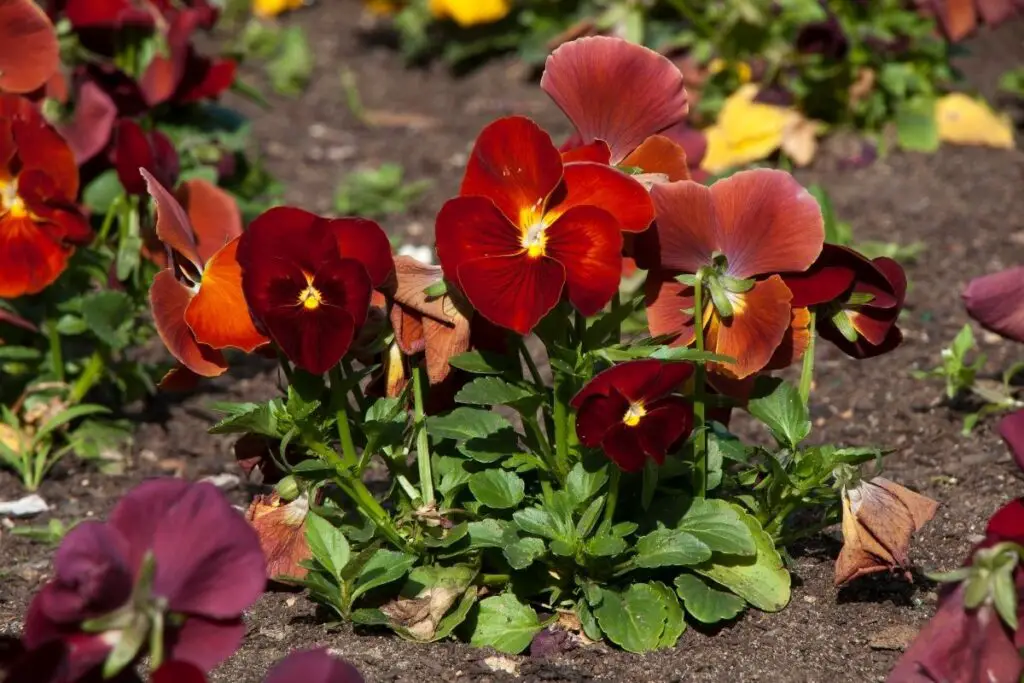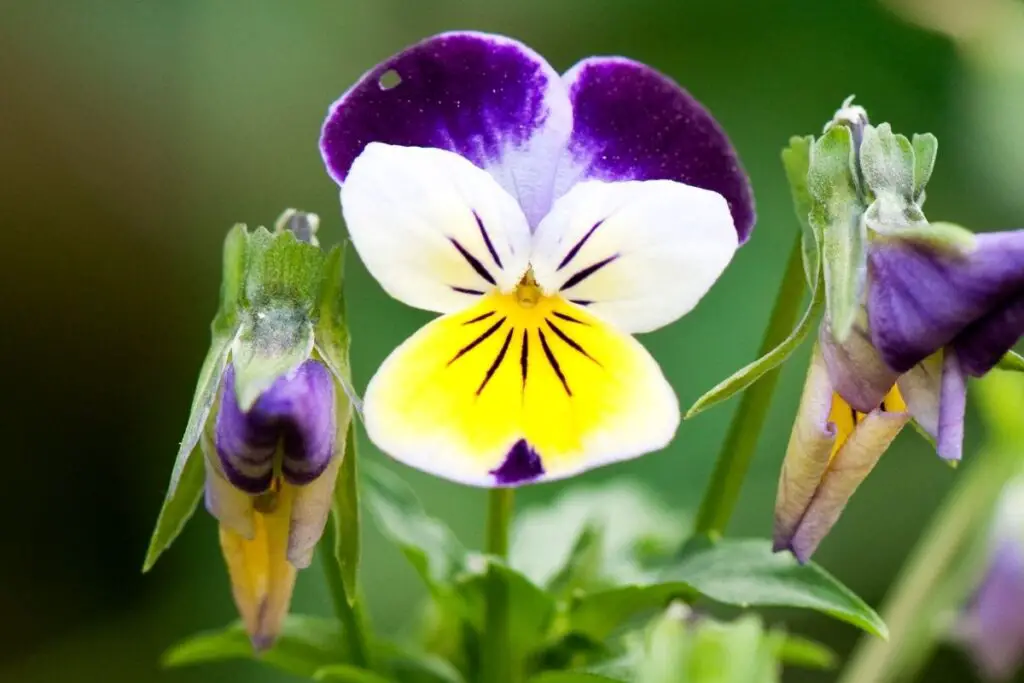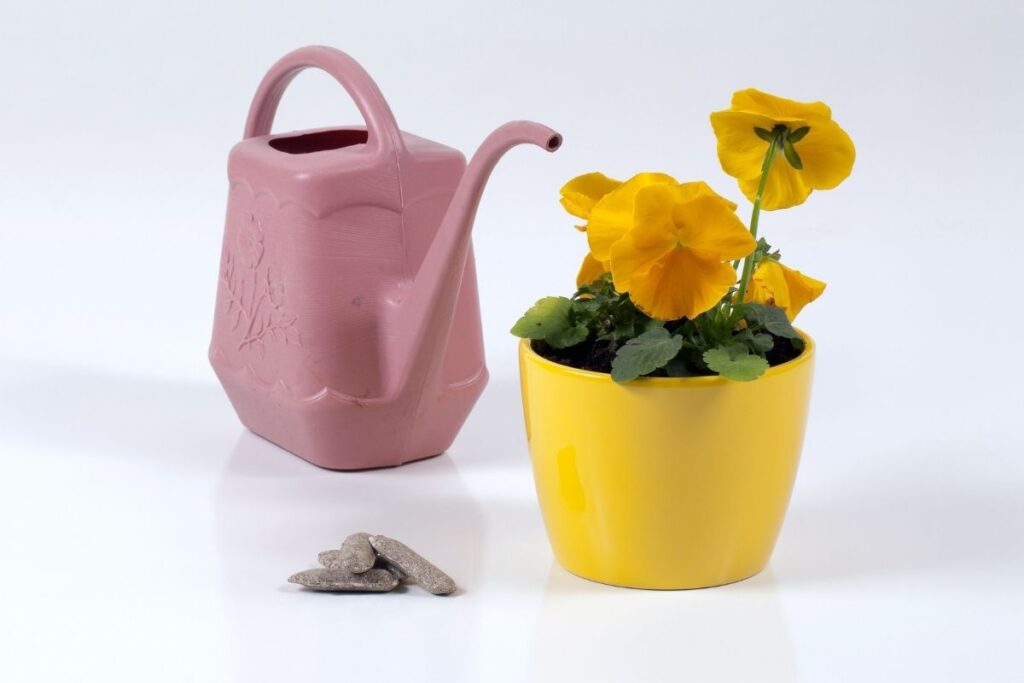Pansies are viola hybrids with a complex ancestry that includes several different species. These flowers brighten up your garden beds during the cooler months in spring and fall. Pansies mostly thrive in cooler climates. They continue to grow and bloom throughout winter and spring.
However, a common thought that crosses everyone’s mind is are pansies perennials?
Pansies are mostly grown as annuals or biennials, so; they are considered short-lived perennials. Pansies are primarily dependent on the climate of a place to survive as they do well in cool weather. Thus, an intense heatwave can wilt your pansy plant, and you might need to start over again.
In this article, we will discuss whether pansies are perennials and how that depends on the climate.

Are pansies annuals or perennials?
Pansies are treated as biennials or short-lived perennials. They can be either an annual or a perennial plant, depending on your climate.
Pansies are delicate, long-lasting plants and can even survive frost and harsh weather if they are taken care of properly. Most gardeners treat these plants as annuals or biennials because they prefer cool weather and get leggy in the summer heat.
In the first year, the pansies produce greenery and bear flowers and seeds in their second year of growth. After that, pansies die like an annual plant.
Pansies are poor heat-tolerant plants which means they cannot survive much in warm weather conditions, and hot temperatures can reduce their blooming capacity.
Pansies are the opposite when it comes to cold. They can survive easily in cold weather. If the blooms wilt in the cold, the pansies will not die. They will stay alive to bloom again, which makes them a great flowering plant.
They are called biennial as they can survive only for two years. Once the two-year growing cycle of pansies is complete, they die completely.
Pansies can survive up to two years only if the climate conditions in your area are unseasonably cold with lengthy periods of frost or cold snaps.
Do pansies come back every year?
No, pansies will not bloom every year so if you are expecting that, be prepared for heartbreak.
Pansies are not perennials. These are primarily annual or biennial species that seem like perennials when they re-seed.
Pansies re-seed under suitable weather conditions where the summers are cool and comfortable for them.
It depends on the temperature whether pansies will come back or not.
Many pansies do not tolerate freeze very well, so they die in freezing winters.
Areas with moderate temperatures help the pansies to come again in spring, especially if you had mulched them to protect the roots.
Pansies can behave like perennials in areas that have short freezing periods, cool summers, and moderate temperatures.
Like in the Pacific Northwest, pansies will often come back the following year, and their seedlings will provide year after year of colors because they have cool temperatures to support the growth.
But gardeners in the Midwest and south assume their plants as annuals because such areas have hot weather conditions. Pansies should be treated as short-lived perennials as they hardly come back year after year.
How long do pansies last?
We have already discussed that pansies can be either annuals or biennials, and sometimes they can be perennials. Annual pansies can last up to eight months or one year if planted in the autumn, from August to April or May.
After one year, when the extreme heat arrives, pansies begin to die.
Pansies can also be treated as biennials and can survive up to two years. Once the two-year growing cycle is complete, pansies die back completely.
Pansies are cool-weather biennials, and they can survive freezing temperatures when they are dormant. Pansies roots can survive winter temperatures as low as minus 25 degrees under the soil.
If summers are cool where you live, your pansies can also live for three years, and they will eventually be known as perennial pansies.
Looking for gardening supplies? We have tested 100's of products before recommending them to you guys. Check out our best pick below:
| Image | Gardening Supplies | Best Price? |
|---|---|---|
 Top
Top Top
Top | Raised Garden Bed Kit | Check On Amazon |
 | XLUX Soil Moisture Meter, Plant Water Monitor, Soil Hygrometer Sensor for Gardening, Farming, Indoor and Outdoor Plants, No Batteries Required | No Results |
 Top
Top Top
Top | 82 Pcs Garden Tools Set and Extra Succulent Tools Set | Check On Amazon |
 | Joeys Garden Expandable Garden Hose with 8 Function Hose Nozzle, Lightweight Anti-Kink Flexible Garden Hoses, Extra Strength Fabric with Double Latex Core, (50 FT, Black) | No Results |
 Top
Top Top
Top | Dual Chamber Compost Tumbler | Check On Amazon |
 Top
Top Top
Top | Sunnyglade Plant Stakes | Check On Amazon |
 Top
Top Top
Top | Organic Cold Pressed Neem Seed Oil | Check On Amazon |
 Top
Top Top
Top | Mighty Mint Gallon :-Insect and Pest Control Peppermint Oil | Check On Amazon |
 Top
Top Top
Top | Scotts DiseaseEx Lawn Fungicide | Check On Amazon |
 Top
Top Top
Top | Jacks Classic 20-20-20 All Purpose Fertilizer | Check On Amazon |
 Top
Top Top
Top | 30,000 Seeds Pollinator Attracting Wildflower Mixture | Check On Amazon |
 Top
Top Top
Top | Survival Vegetable Seeds Garden Kit-Over 16,000 Seeds | Check On Amazon |
Do pansies bloom more than once?

Pansies grow best when the temperatures are between 45°F at night and 60°F during the day.
Pansies can bloom in the fall but can bloom again in spring if you care well for them.
Pansies continue to come up in the spring and keep blooming until the temperatures rise and bring dormancy to the plants.
When temperatures go down in the fall, pansies might bloom again if you take some time to prepare them in the spring.
Although the plants and the foliage will remain healthy during winter, you won’t find flowers on them.
How to make pansies bloom again?
Here are certain steps you need to follow to make sure that your pansies bloom again.
- You should remove all dying blooms from the pansy plant to encourage the plant to bloom more.
- Keep the soil moist and apply a phosphorus fertilizer.
- Prune overgrowth and leggy stems on the pansy plants.
- Remove the seed pods before the seeds form entirely and check for seed pods that were not pinched back.
How can we grow pansies as a perennial plant?
Many factors affect the survival of pansies. If the pansies are taken care of properly, they can survive up to 3 years.
Factors you need to remember are:
- Climate requirements
- Soil composition
- Sunlight requirements
- Watering
- Nutrition
- Mulching
- Pruning
Climate requirements for pansies
Pansies grow and bloom during the cool fall, winter, and spring months when the temperatures remain above freezing.
In warmer climates, you should plant your pansy seedlings in the fall. And in a cooler climate, you should plant the pansies in the early spring.
Plant your pansy seedlings when the soil temperatures are between 45°F and 65°F to get the best results.
Soil composition
Pansies prefer loamy soil that drains well and retains sufficient moisture, so it does not dry out completely. Add plenty of organic matter and well-decomposed compost to the soil for the healthy growth of pansies.
Pansies grow best in slightly acidic soil with a pH of 6.0-6.2.
Try to maintain the soil’s moisture level, but make sure it is not soggy as it can cause root rot, and the survival of pansies eventually reduces.
Sunlight requirements
Pansies need at least 6 hours of direct sunlight. Place your pansies in an area with full sun or partial sun.
In a cooler climate, you should never add too much shade, as this will reduce the blooming rate of pansies. Pansies will need direct sunlight if temperatures remain below 70-75°F during the day.
When the heat increases, pansies will not prefer long hours of intense sunlight that makes them dry. You must ensure to provide sufficient humidity and shade from the intense light and heat in such conditions.
Shade is beneficial for pansies only when the climate is warm.
Also read: How Much Sun Do Pansies Need? (Pansies Light Requirements)
Watering
Pansies need a good moisture level in the soil to grow well, but they should not be soggy. Pansies just need 1 inch of water per week when they are actively growing.
Due to improper watering, pansies will not survive for so long, and they will die back completely.
Pansies never like to sit in wet soil, and you must check the soil whether it’s dried out or not and water it accordingly.
Consistent moisture keeps the pansies healthy and soft, but if you overwater your pansies, it will cause root rot to the pansies.
Water pansies regularly in the growing season but allow the soil to dry slightly before watering.
The drier soil conditions also help pansies to tolerate cold. Try to avoid underwatering and overwatering for the healthy growth of pansies.
Also read: How Much Water Does A Pansy Need? (Pansy Water Requirements)
Nutrition

You should fertilize your pansy plant about once a month to ensure the healthy growth of a plant. You can use a water-soluble nitrogen fertilizer to encourage root and plant growth.
You should mix it with water and apply it every month to get the best results.
You can also use phosphorus fertilizers to promote flowering.
Make sure you don’t overfertilize your pansies, as this will make pansy leggy.
You can nourish your pansies by adding a premium potting mix.
Always follow the label’s direction before using fertilizers.
Also read: Do Pansies Need Fertilizer? (What Type, How Much & More)
Mulching
Mulching helps to add soil moisture and prevents it from drying out too quickly.
To protect your daisies throughout the winter and summer, you must spread at least 2 to 3 inches of mulch over the pansies.
Mulch around your pansies using organic material such as pine straw or pine bark to help conserve moisture.
Mulching helps to retain moisture and break into essential nutrients needed for the pansies for healthy growth, making them last longer.
Pruning
Pruning your pansies is vital. You should remove the dead flowers, injured leaves, and seed pots to ensure the return of flowers.
If your pansies become leggy, you can prune them and let them regrow to a more compact shape. This will ensure more flowering and stable growth of your plant. Pruning your pansies helps them to maintain their overall health.
If you do not prune the pansies correctly, the infected parts will remain attached to the plant, which will make other healthy parts of pansies ill, because of which the plant will wilt and die.
Final words
Pansies are treated as biennials or short-lived perennials. They are mainly grown as annual or perennial plants. Pansies hardly come back year after year as they are mostly annuals or biennials.
Pansies can survive up to 1 to 2 years, but if they are taken care of properly, these plants can survive for three years.
Pansies can bloom more than once if you take proper care of them.
Different factors can affect the growth and life of the pansies. If the climate, soil composition, sunlight, watering, nutrition, mulching, and pruning are maintained properly, these plants will survive for a longer time.
Ref: The University of Arkansas, Britannica, Utah State University, Wikipedia, The University of Georgia, The Pennsylvania State University, The Royal Horticultural Society.
